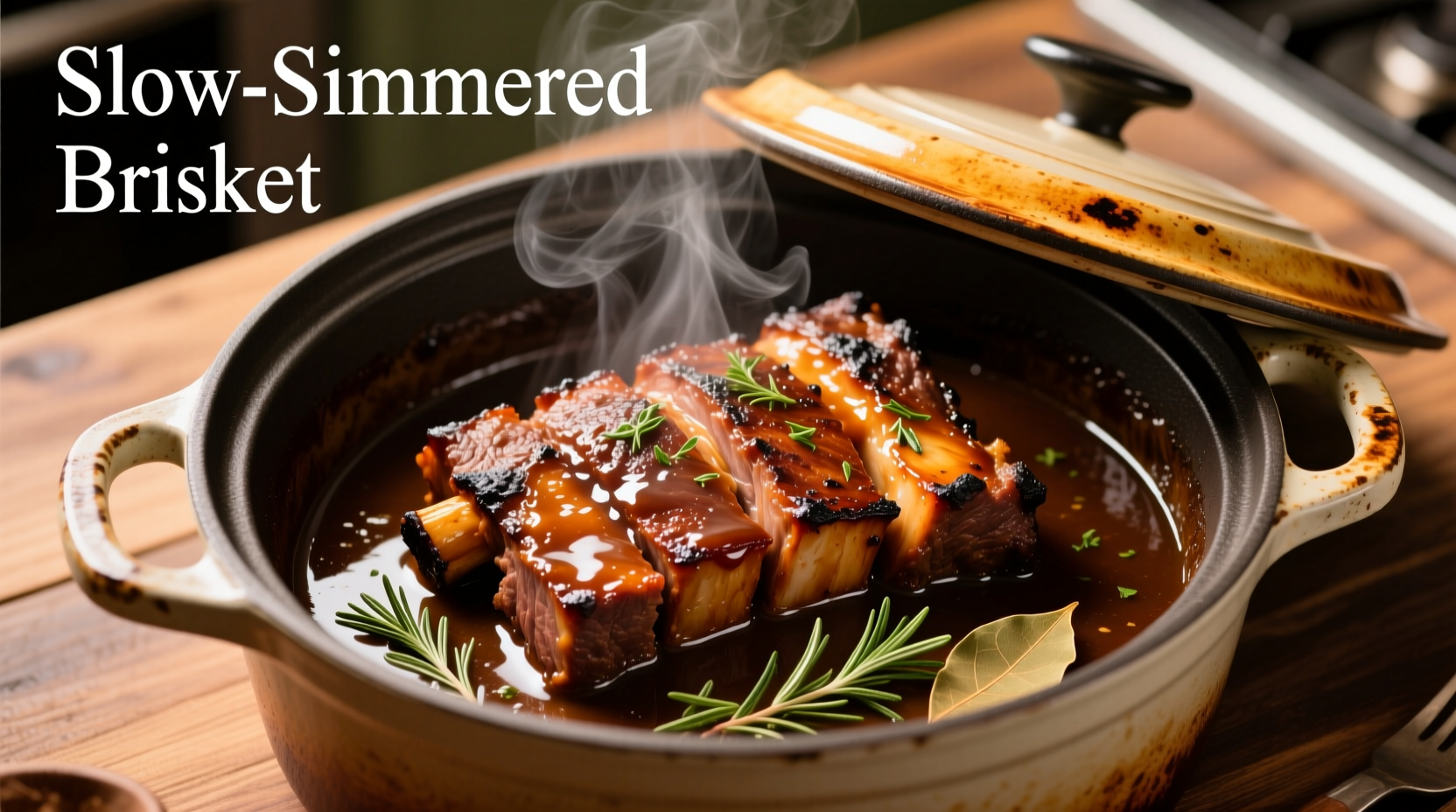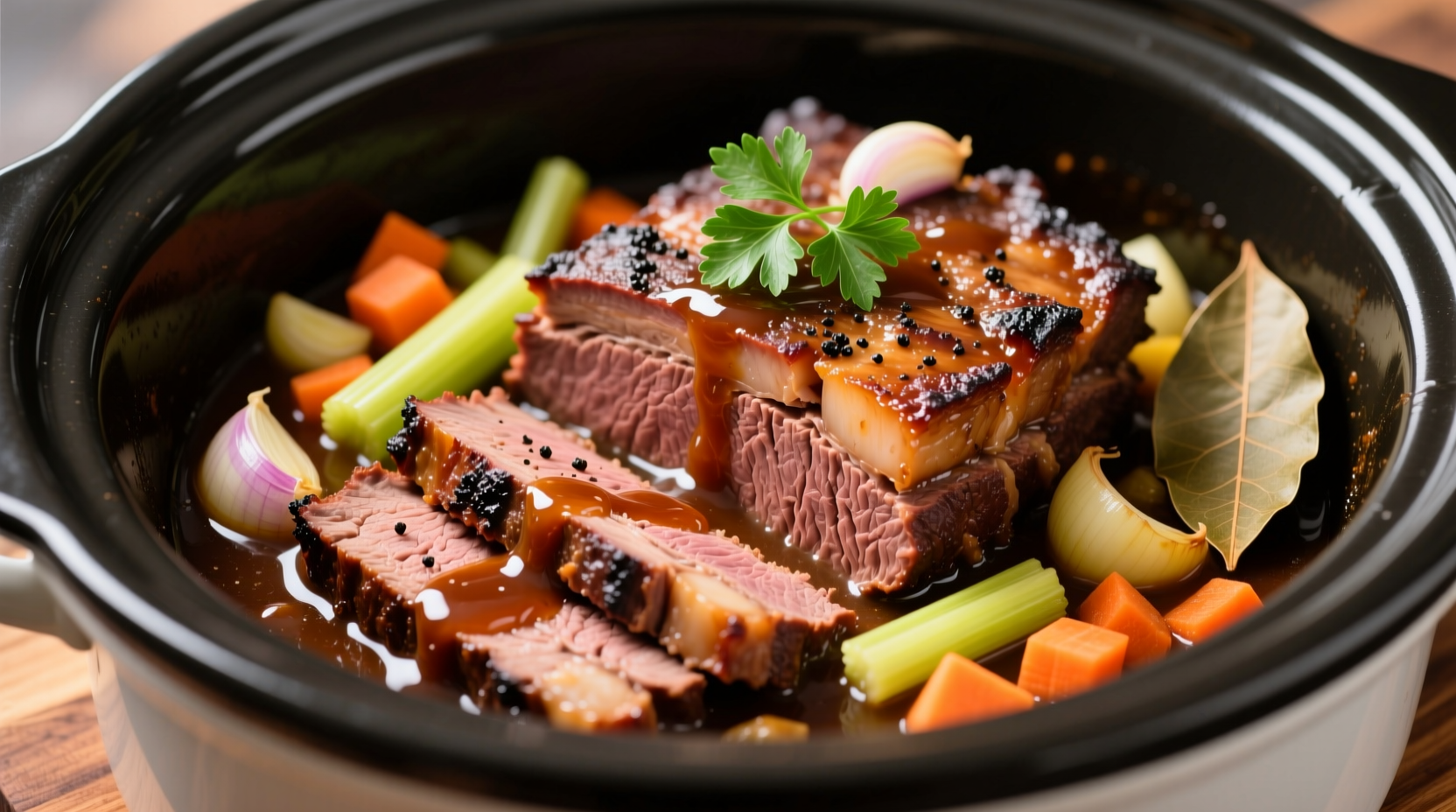For perfectly tender crock pot brisket, cook a 3-4 pound cut at low temperature (200°F) for 8-10 hours with 1 cup liquid until internal temperature reaches 195-205°F. Always rest 30 minutes before slicing against the grain for maximum tenderness.
Why Your Crock Pot Brisket Will Turn Out Perfectly Every Time
Nothing beats the convenience of transforming a tough cut of meat into fork-tender perfection with minimal hands-on time. This crock pot brisket method delivers consistent results whether you're cooking for a family dinner or meal prepping for the week. You'll get melt-in-your-mouth texture without the stress of oven monitoring or grill temperature fluctuations.
The Science Behind Slow-Cooked Brisket Success
Understanding the food science transforms good brisket into extraordinary brisket. When brisket hits 160°F, collagen begins breaking down into gelatin—the secret to that signature melt-in-your-mouth texture. The USDA Food Safety and Inspection Service confirms that while 145°F is the minimum safe temperature for beef, tough cuts require higher temperatures (195-205°F) for optimal tenderness.
| Brisket Weight | Low Setting Time | High Setting Time | Internal Temp Target |
|---|---|---|---|
| 2-3 lbs | 6-7 hours | 4-5 hours | 195-205°F |
| 3-4 lbs | 8-10 hours | 5-6 hours | 195-205°F |
| 4-5 lbs | 10-12 hours | 6-8 hours | 195-205°F |
Choosing Your Brisket: What Really Matters
Not all brisket cuts behave the same in slow cookers. The flat cut (first cut) has less fat but can dry out if overcooked, while the point cut (second cut) contains more marbling for forgiving results. For crock pot cooking, select a 3-4 pound piece with even marbling—this size fits most standard 6-quart slow cookers without folding. The American Meat Science Association notes that brisket's high connective tissue content requires slow, moist heat to achieve tenderness.
Prep Work That Makes the Difference
Seasoning isn't just about flavor—it creates the crucial bark that protects meat during long cooking. Pat the brisket dry, then apply 1 tablespoon coarse salt and 2 teaspoons black pepper per pound. For deeper flavor development, sear all sides in 1 tablespoon oil over medium-high heat until deeply browned (about 3 minutes per side). This Maillard reaction creates complex flavor compounds that simmering alone can't achieve.

Building Flavor Layers in Your Liquid Base
The cooking liquid does double duty as both flavor enhancer and natural gravy base. Combine 1 cup liquid with these proportions for balanced results:
- 50% broth (beef or vegetable)
- 25% acidic component (tomato paste, vinegar, or citrus juice)
- 25% flavor boosters (Worcestershire, soy sauce, or coffee)
Add aromatics like 2 smashed garlic cloves, 1 sliced onion, and fresh herbs. The National Center for Home Food Preservation emphasizes that maintaining proper liquid levels prevents scorching and ensures even heat transfer in slow cookers.
Cooking Process: Timing and Temperature Control
Place the seared brisket fat-side up in the crock pot and pour liquid mixture around (not over) the meat. Cook on LOW for 8-10 hours—never HIGH, which can make the exterior mushy while the center remains tough. Check tenderness at 8 hours: the meat should pull apart easily with two forks. Insert a thermometer into the thickest part; it must read 195-205°F for proper collagen breakdown. Resist the urge to lift the lid frequently—each peek adds 20 minutes to cooking time.
The Non-Negotiable Resting Phase
Resting isn't optional—it's when the magic happens. Transfer brisket to a cutting board, tent loosely with foil, and rest for 30 minutes. During this time, juices redistribute throughout the meat fibers. The James Beard Foundation's culinary research shows that proper resting increases moisture retention by up to 40% compared to immediate slicing.
Serving Like a Pro: Slicing and Sauce Secrets
Identify the grain direction by looking for parallel muscle fibers. Slice perpendicular to the grain in 1/4-inch thick pieces—this shortens tough fibers for easier chewing. For instant gravy, skim fat from cooking liquid, then simmer until reduced by half. Whisk in 1 tablespoon cornstarch slurry (1:1 cornstarch:water) for perfect consistency. Serve with roasted vegetables or creamy mashed potatoes to balance the rich flavors.
Troubleshooting Common Crock Pot Brisket Issues
Dry results? Likely overcooked or insufficient liquid. Next time, reduce cooking time by 1 hour and ensure liquid covers 1/3 of the meat. Tough texture? Didn't reach proper internal temperature—always verify with a thermometer. Excess fat? Trim visible fat caps before cooking and chill cooking liquid to easily remove solidified fat.
Frequently Asked Questions
Can I cook frozen brisket in a crock pot?
No, always thaw brisket completely before slow cooking. Cooking frozen meat creates unsafe temperature zones where bacteria can grow. The USDA Food Safety and Inspection Service requires that frozen meats be fully thawed before slow cooking to ensure food safety.
How do I prevent my brisket from becoming mushy?
Avoid cooking on HIGH setting and don't exceed 10 hours for most cuts. The ideal window is when internal temperature reaches 200°F—beyond this point, muscle fibers begin breaking down excessively. Check tenderness hourly after the 8-hour mark.
Can I use a spice rub with sugar in a crock pot?
Yes, but apply sugar-based rubs during the last 2 hours of cooking. Extended exposure to moist heat causes sugars to break down and potentially burn. For best results, sear with dry rub first, then add sugar components near the end.
How long will leftovers stay fresh?
Store sliced brisket in airtight containers with cooking liquid for up to 4 days in the refrigerator. The USDA recommends consuming cooked beef within 3-4 days for optimal safety. For longer storage, freeze portions with liquid for up to 3 months—thaw overnight in the refrigerator before reheating.











 浙公网安备
33010002000092号
浙公网安备
33010002000092号 浙B2-20120091-4
浙B2-20120091-4